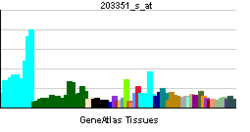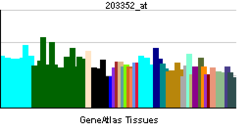- ORC4L
-
Origin recognition complex subunit 4 is a protein that in humans is encoded by the ORC4L gene.[1][2][3]
The origin recognition complex (ORC) is a highly conserved six subunit protein complex essential for the initiation of the DNA replication in eukaryotic cells. Studies in yeast demonstrated that ORC binds specifically to origins of replication and serves as a platform for the assembly of additional initiation factors such as Cdc6 and Mcm proteins. The protein encoded by this gene is a subunit of the ORC complex. It has been shown to form a core complex with ORC2L, -3L, and -5L. Three alternatively spliced transcript variants encoding the same protein have been reported.[3]
Interactions
ORC4L has been shown to interact with ORC1L,[4] MCM6,[4] ORC2L,[1][4][5][6] ORC5L,[4][5][7] ORC3L,[5][6][8] MCM2,[4] MCM4,[4] MCM3[4] and ORC6L.[4]
References
- ^ a b Quintana DG, Hou Zh, Thome KC, Hendricks M, Saha P, Dutta A (December 1997). "Identification of HsORC4, a member of the human origin of replication recognition complex". J Biol Chem 272 (45): 28247–51. doi:10.1074/jbc.272.45.28247. PMID 9353276.
- ^ Eki T, Dean FB, Kohda A, Okumura K, Abe M, Murakami Y, Ishiai M, Satomoto K, Hurwitz J, O'Donnell M, Hanaoka F (October 1998). "Assignment of the homologue of the yeast origin recognition complex subunit ORC4 (ORC4L) to human chromosome band 2q22→q23 by in situ hybridization and somatic cell hybrid analysis". Cytogenet Cell Genet 81 (1): 89–90. doi:10.1159/000014997. PMID 9691185.
- ^ a b "Entrez Gene: ORC4L origin recognition complex, subunit 4-like (yeast)". http://www.ncbi.nlm.nih.gov/sites/entrez?Db=gene&Cmd=ShowDetailView&TermToSearch=5000.
- ^ a b c d e f g h Kneissl, Margot; Pütter Vera, Szalay Aladar A, Grummt Friedrich (March 2003). "Interaction and assembly of murine pre-replicative complex proteins in yeast and mouse cells". J. Mol. Biol. (England) 327 (1): 111–28. doi:10.1016/S0022-2836(03)00079-2. ISSN 0022-2836. PMID 12614612.
- ^ a b c Dhar, S K; Delmolino L, Dutta A (August 2001). "Architecture of the human origin recognition complex". J. Biol. Chem. (United States) 276 (31): 29067–71. doi:10.1074/jbc.M103078200. ISSN 0021-9258. PMID 11395502.
- ^ a b Vashee, S; Simancek P, Challberg M D, Kelly T J (July 2001). "Assembly of the human origin recognition complex". J. Biol. Chem. (United States) 276 (28): 26666–73. doi:10.1074/jbc.M102493200. ISSN 0021-9258. PMID 11323433.
- ^ Quintana, D G; Thome K C, Hou Z H, Ligon A H, Morton C C, Dutta A (October 1998). "ORC5L, a new member of the human origin recognition complex, is deleted in uterine leiomyomas and malignant myeloid diseases". J. Biol. Chem. (UNITED STATES) 273 (42): 27137–45. doi:10.1074/jbc.273.42.27137. ISSN 0021-9258. PMID 9765232.
- ^ Pinto, S; Quintana D G, Smith P, Mihalek R M, Hou Z H, Boynton S, Jones C J, Hendricks M, Velinzon K, Wohlschlegel J A, Austin R J, Lane W S, Tully T, Dutta A (May 1999). "latheo encodes a subunit of the origin recognition complex and disrupts neuronal proliferation and adult olfactory memory when mutant". Neuron (UNITED STATES) 23 (1): 45–54. doi:10.1016/S0896-6273(00)80752-7. ISSN 0896-6273. PMID 10402192.
Further reading
- Maruyama K, Sugano S (1994). "Oligo-capping: a simple method to replace the cap structure of eukaryotic mRNAs with oligoribonucleotides.". Gene 138 (1–2): 171–4. doi:10.1016/0378-1119(94)90802-8. PMID 8125298.
- Suzuki Y, Yoshitomo-Nakagawa K, Maruyama K et al. (1997). "Construction and characterization of a full length-enriched and a 5'-end-enriched cDNA library". Gene 200 (1–2): 149–56. doi:10.1016/S0378-1119(97)00411-3. PMID 9373149.
- Tugal T, Zou-Yang XH, Gavin K et al. (1999). "The Orc4p and Orc5p subunits of the Xenopus and human origin recognition complex are related to Orc1p and Cdc6p". J. Biol. Chem. 273 (49): 32421–9. doi:10.1074/jbc.273.49.32421. PMID 9829972.
- Springer J, Kneissl M, Pütter V, Grummt F (1999). "Identification and characterization of MmORC4 and MmORC5, two subunits of the mouse origin of replication recognition complex". Chromosoma 108 (4): 243–9. doi:10.1007/s004120050374. PMID 10460412.
- Jiang W, McDonald D, Hope TJ, Hunter T (1999). "Mammalian Cdc7-Dbf4 protein kinase complex is essential for initiation of DNA replication". EMBO J. 18 (20): 5703–13. doi:10.1093/emboj/18.20.5703. PMC 1171637. PMID 10523313. http://www.pubmedcentral.nih.gov/articlerender.fcgi?tool=pmcentrez&artid=1171637.
- Thome KC, Dhar SK, Quintana DG et al. (2001). "Subsets of human origin recognition complex (ORC) subunits are expressed in non-proliferating cells and associate with non-ORC proteins". J. Biol. Chem. 275 (45): 35233–41. doi:10.1074/jbc.M005765200. PMID 10954718.
- Vashee S, Simancek P, Challberg MD, Kelly TJ (2001). "Assembly of the human origin recognition complex". J. Biol. Chem. 276 (28): 26666–73. doi:10.1074/jbc.M102493200. PMID 11323433.
- Dhar SK, Delmolino L, Dutta A (2001). "Architecture of the human origin recognition complex". J. Biol. Chem. 276 (31): 29067–71. doi:10.1074/jbc.M103078200. PMID 11395502.
- Okuno Y, McNairn AJ, den Elzen N et al. (2001). "Stability, chromatin association and functional activity of mammalian pre-replication complex proteins during the cell cycle". EMBO J. 20 (15): 4263–77. doi:10.1093/emboj/20.15.4263. PMC 149150. PMID 11483529. http://www.pubmedcentral.nih.gov/articlerender.fcgi?tool=pmcentrez&artid=149150.
- Strausberg RL, Feingold EA, Grouse LH et al. (2003). "Generation and initial analysis of more than 15,000 full-length human and mouse cDNA sequences". Proc. Natl. Acad. Sci. U.S.A. 99 (26): 16899–903. doi:10.1073/pnas.242603899. PMC 139241. PMID 12477932. http://www.pubmedcentral.nih.gov/articlerender.fcgi?tool=pmcentrez&artid=139241.
- Kneissl M, Pütter V, Szalay AA, Grummt F (2003). "Interaction and assembly of murine pre-replicative complex proteins in yeast and mouse cells". J. Mol. Biol. 327 (1): 111–28. doi:10.1016/S0022-2836(03)00079-2. PMID 12614612.
- Ota T, Suzuki Y, Nishikawa T et al. (2004). "Complete sequencing and characterization of 21,243 full-length human cDNAs". Nat. Genet. 36 (1): 40–5. doi:10.1038/ng1285. PMID 14702039.
- Ramachandran N, Hainsworth E, Bhullar B et al. (2004). "Self-assembling protein microarrays". Science 305 (5680): 86–90. doi:10.1126/science.1097639. PMID 15232106.
- Gerhard DS, Wagner L, Feingold EA et al. (2004). "The status, quality, and expansion of the NIH full-length cDNA project: the Mammalian Gene Collection (MGC)". Genome Res. 14 (10B): 2121–7. doi:10.1101/gr.2596504. PMC 528928. PMID 15489334. http://www.pubmedcentral.nih.gov/articlerender.fcgi?tool=pmcentrez&artid=528928.
- Sibani S, Price GB, Zannis-Hadjopoulos M (2005). "Ku80 binds to human replication origins prior to the assembly of the ORC complex". Biochemistry 44 (21): 7885–96. doi:10.1021/bi047327n. PMID 15910003.
- Rual JF, Venkatesan K, Hao T et al. (2005). "Towards a proteome-scale map of the human protein-protein interaction network". Nature 437 (7062): 1173–8. doi:10.1038/nature04209. PMID 16189514.
Categories:- Human proteins
- Chromosome 2 gene stubs
Wikimedia Foundation. 2010.


